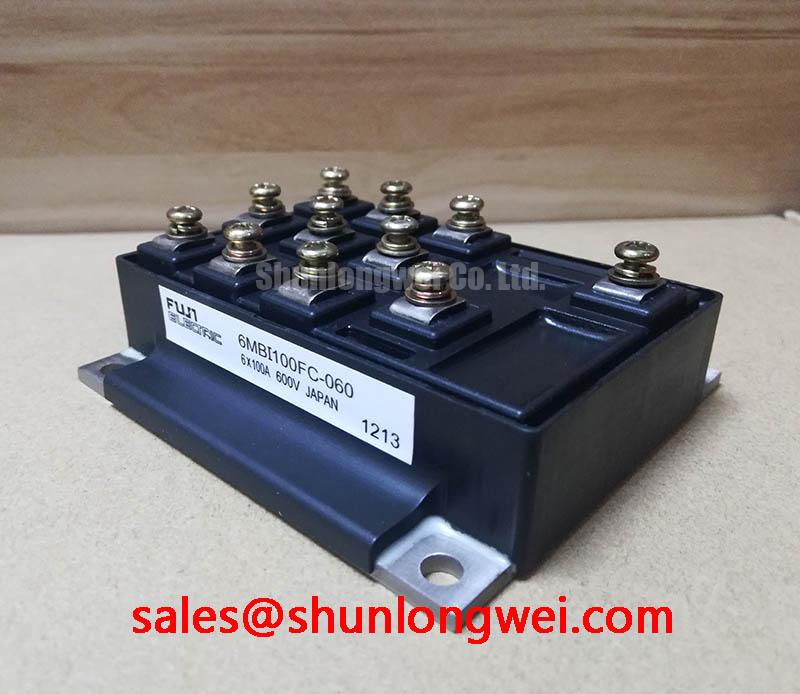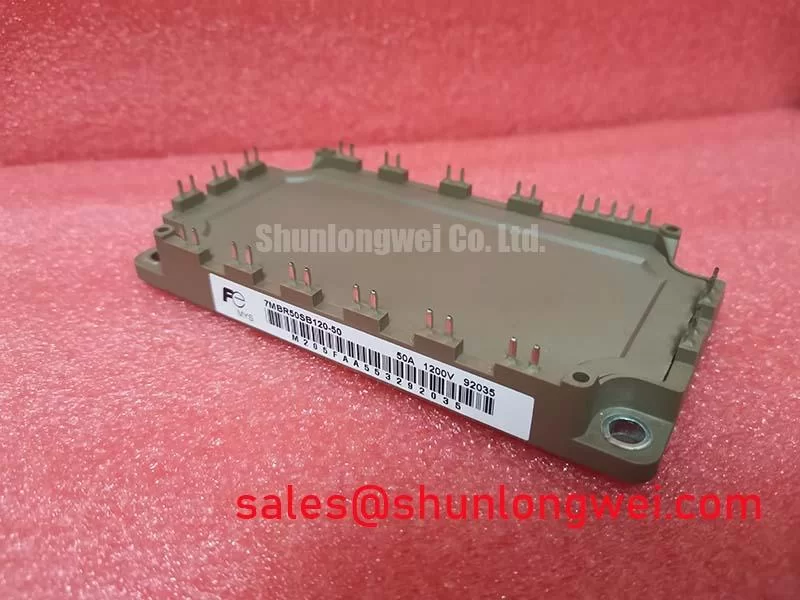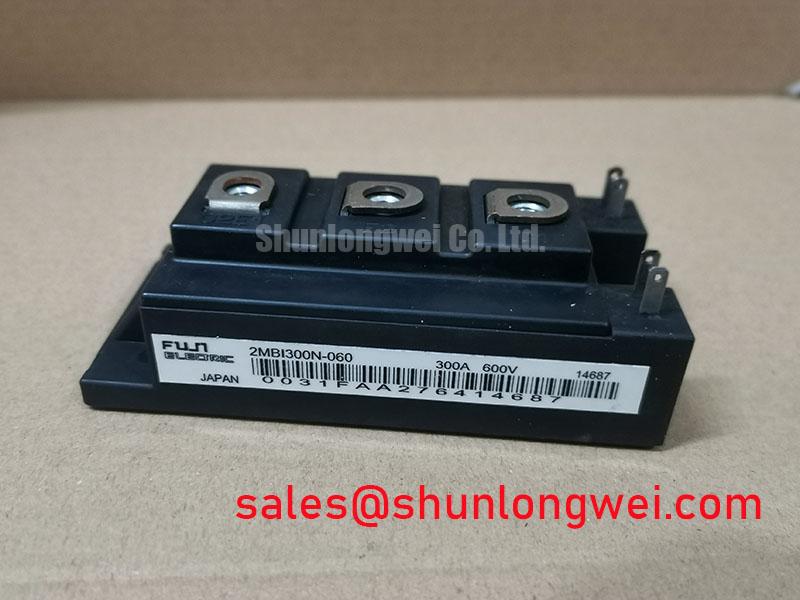Content last revised on November 19, 2025
6MBI100FC-060 | 600V 100A 6-Pack IGBT Module for High-Efficiency Inverters
Product Overview: Key Specifications and Engineering Advantages
Engineered for high-efficiency power conversion, the Fuji Electric 6MBI100FC-060 minimizes both conduction and switching losses in demanding applications. This module integrates a three-phase bridge of six IGBTs with co-packaged Free Wheeling Diodes (FWDs) into a compact, low-inductance package. Its core specifications are 600V | 100A | VCE(sat) 2.0V (typ). The key engineering benefits include significantly reduced thermal load and the potential for increased system power density. By utilizing advanced Field-Stop and Trench-Gate technology, the FC-Series delivers a superior low-loss performance crucial for modern inverter designs. For three-phase inverters in the 20-40 kW range requiring minimal conduction losses, the 6MBI100FC-060 offers a compelling balance of performance and thermal efficiency.
Key Parameter Overview
Decoding the Specs for Optimized Inverter Efficiency
The technical specifications of the 6MBI100FC-060 are tailored for applications where efficiency and thermal performance are paramount. The highlighted parameters below are critical for system-level design and optimization.
| Parameter | Symbol | Condition | Value |
|---|---|---|---|
| Collector-Emitter Voltage | Vces | Tj = 25°C | 600V |
| Continuous Collector Current | Ic | Tc = 80°C | 100A |
| Collector-Emitter Saturation Voltage | VCE(sat) | Ic = 100A, Tj = 125°C | 2.0V (typ) / 2.5V (max) |
| Forward Voltage (FWD) | Vf | If = 100A, Tj = 125°C | 1.8V (typ) / 2.3V (max) |
| Turn-on Switching Loss | Eon | Ic = 100A, Tj = 125°C | 15 mJ (typ) |
| Turn-off Switching Loss | Eoff | Ic = 100A, Tj = 125°C | 22 mJ (typ) |
| Thermal Resistance (Junction to Case, IGBT) | Rth(j-c) | Per arm | 0.19 K/W (max) |
| Operating Junction Temperature | Tj(op) | - | +150°C |
Download the 6MBI100FC-060 datasheet for detailed specifications and performance curves.
Application Scenarios & Value
Achieving System-Level Benefits in High-Frequency Power Conversion
The 6MBI100FC-060 is an optimal choice for power conversion systems where minimizing heat dissipation is a primary design driver. Its characteristics deliver tangible value in applications such as:
- Variable Frequency Drives (VFDs): In compact motor drives for industrial automation, space for thermal management is often limited. The low VCE(sat) of this module directly reduces conduction losses—the primary source of heat at lower to medium Pulse Width Modulation (PWM) frequencies. This enables the use of smaller, more cost-effective heatsinks or allows for operation at higher ambient temperatures without derating, a critical factor in enclosed control cabinets.
- Uninterruptible Power Supplies (UPS): High efficiency is essential for reducing the total cost of ownership (TCO) in UPS systems. The 6MBI100FC-060's balanced switching and conduction performance helps maximize inverter efficiency, leading to lower energy consumption and reduced cooling requirements for the overall system.
- Welding Power Supplies: The module's robust thermal characteristics and ability to handle high current pulses make it a reliable component for the inverter stage of modern welding equipment.
What is the main benefit of its low conduction loss? Reduced heat generation, which allows for smaller heatsinks and higher system power density. While this model is well-suited for 100A applications, for systems demanding higher output power within a similar package, the related 6MBI150FA-060 offers a 150A capability.
Frequently Asked Questions
Engineering Inquiries for the 6MBI100FC-060
How does the typical VCE(sat) of 2.0V directly impact the thermal design of a variable frequency drive (VFD)?
A lower VCE(sat) directly translates to lower power dissipation (P_loss = VCE(sat) * Ic) during the on-state. For a 100A load, this module's typical 2.0V VCE(sat) results in 200W of conduction loss per switch. A competing device with a 2.3V VCE(sat) would generate 230W—a 15% increase. This additional 30W of waste heat per switch must be managed by the heatsink, potentially requiring a larger, heavier, and more expensive thermal solution to maintain the same junction temperature.
What is the significance of the integrated FWD's reverse recovery characteristics in this module?
The soft recovery characteristic of the built-in Free Wheeling Diode (FWD) is crucial for reducing voltage overshoots and electromagnetic interference (EMI). During IGBT turn-on, the FWD in the opposing switch must turn off. A "snappy" or fast-recovery diode can cause high voltage spikes and ringing, requiring larger snubber circuits and more extensive EMI filtering. A soft-recovery diode, as found in the 6MBI100FC-060, helps to ensure cleaner switching waveforms and simplifies system-level compliance with standards like IEC 61800-3 for electromagnetic compatibility.
Is the 6MBI100FC-060 suitable for high switching frequency applications?
This module is optimized for a balance between conduction and switching losses, making it ideal for frequencies typically found in motor drives and UPS systems (e.g., 2 kHz to 15 kHz). While it can operate at higher frequencies, designers must carefully analyze the trade-off, as switching losses (Eon and Eoff) become more dominant with increasing frequency, leading to higher overall heat generation. A thorough thermal analysis is essential for such designs.
Technical Deep Dive
A Closer Look at the NPT and Trench Gate Structure
The performance of the 6MBI100FC-060 is rooted in its advanced semiconductor design, specifically the combination of a Non-Punch-Through (NPT) structure with a Trench Gate. This architecture is engineered to resolve the classic trade-off between conduction losses and switching speed. Think of the Trench Gate as creating a wider, more direct 'highway' for current to flow when the device is on. This vertical gate structure increases the channel density on the chip surface, drastically reducing the on-state resistance—the primary factor behind VCE(sat). This is how the module achieves its low conduction losses.
Simultaneously, the NPT design with a field-stop layer ensures that the device can be turned off quickly. The field-stop layer acts as an abrupt 'off-ramp' for charge carriers, preventing the long "tail current" that can plague older IGBT technologies. This rapid clearing of charge is what enables lower turn-off energy loss (Eoff) and allows the module to operate efficiently at the multi-kilohertz frequencies common in modern inverters. This combination provides designers with a device that does not force a compromise between low heat from conduction and efficient high-frequency operation.
Industry Insights & Strategic Advantage
Meeting the Demands of Energy Efficiency Mandates
The deployment of components like the 6MBI100FC-060 is strategically aligned with global trends toward stricter energy efficiency regulations. Mandates for industrial motors (e.g., IE3/IE4 efficiency classes) and data centers (e.g., the Energy Star program for UPS) place direct pressure on the power electronics to minimize energy waste. An IGBT module is no longer just a switch; it is a critical enabling technology for system-level compliance and competitive differentiation.
By selecting a module with a low VCE(sat) and optimized switching characteristics, engineering teams can achieve higher overall system efficiency. This not only meets regulatory requirements but also provides a tangible marketing advantage, offering end-users lower operating costs. Furthermore, the higher power density enabled by this module's thermal efficiency supports the trend of equipment miniaturization, allowing for more compact and integrated VFDs, UPS systems, and solar inverters.
Strategic Application Considerations
For engineering teams developing next-generation power converters, the 6MBI100FC-060 provides a direct path to achieving higher efficiency and power density. Its low-loss characteristics reduce the burden on thermal management systems, enabling more compact, reliable, and cost-effective final products. This positions it as a key component for systems where energy savings and a reduced physical footprint are critical design objectives, directly supporting the development of equipment compliant with increasingly stringent global energy standards.












